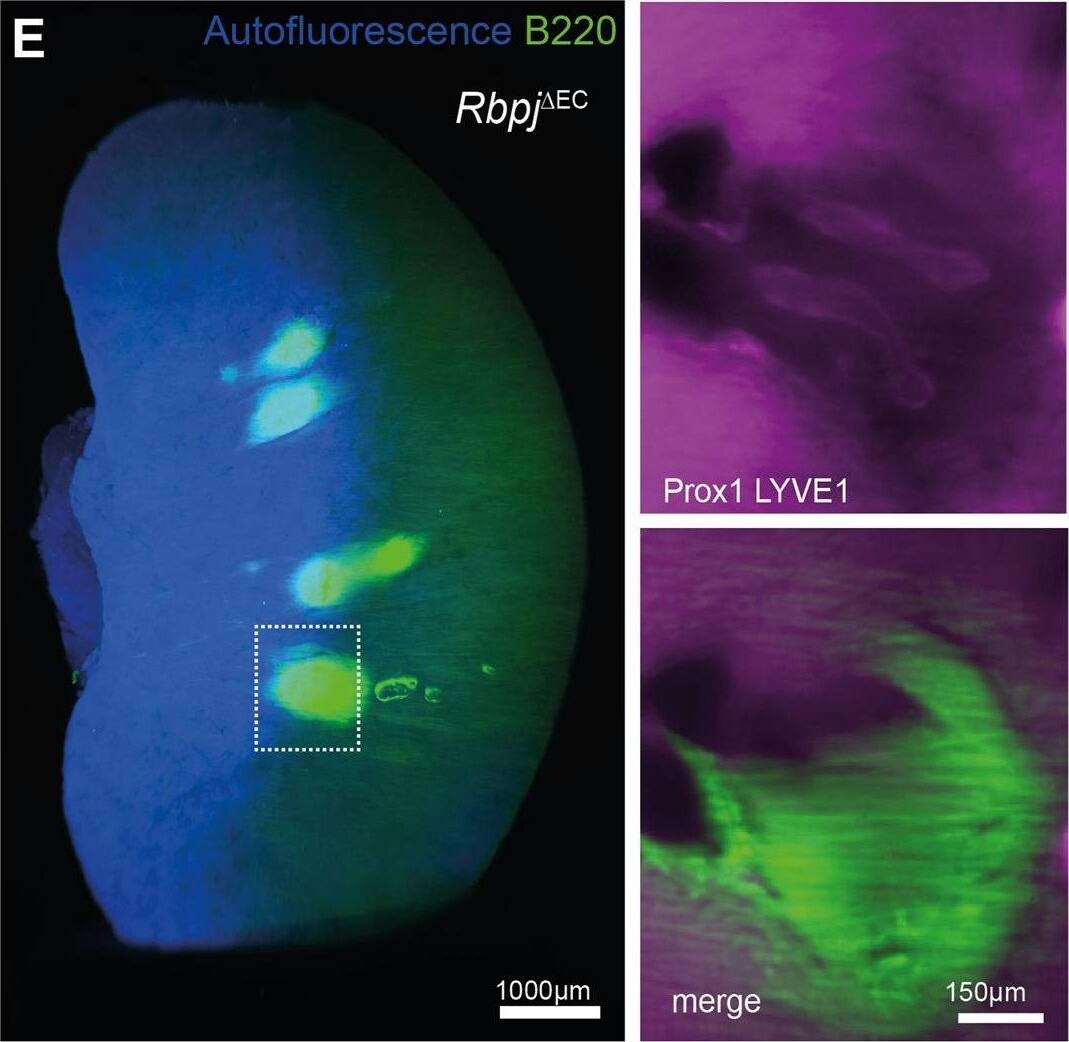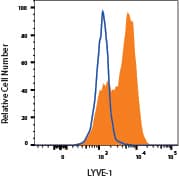LYVE-1 Products
Lymphatic Vessel Endothelial Hyaluronan (HA) Receptor-1 (LYVE-1) is a 60-kDa type I transmembrane glycoprotein that is a member of the Link Protein superfamily. HA is found in the extracellular matrix of most animal tissues and in body fluids. It modulates cell behavior and functions during tissue remodeling, development, homeostasis, and disease. It is often used as a marker of lymphatic endothelia.
LYVE-1 is expressed on both the lumenal and ablumenal surfaces of lymphatic endothelium, and also on hepatic blood sinusoidal endothelia. This expression pattern, combined with studies showing that LYVE-1 can support cellular HA internalization in vitro, may suggest LYVE-1 participation in HA internalization for degradation, or transport of HA from tissues into the lumen of lymphatic vessels. LYVE-1-directed HA localization to lymphatic surfaces might also affect aspects of the immune response or tumor metastases. HA binding to CD44 can still occur in the presence of LYVE-1 in vitro. Therefore, LYVE-1-directed HA localization to lymphatics could provide a substrate for transmigrating CD44+ leukocytes or tumor cells. In addition to hepatic and lymphatic endothelia, some expression of LYVE-1 has been reported on Kupffer cells, the islets of Langerhans, cortical neurons, and renal epithelium. Roles for LYVE-1 on these cell and tissue types remain to be determined.
188 results for "LYVE-1" in Products
188 results for "LYVE-1" in Products
LYVE-1 Products
Lymphatic Vessel Endothelial Hyaluronan (HA) Receptor-1 (LYVE-1) is a 60-kDa type I transmembrane glycoprotein that is a member of the Link Protein superfamily. HA is found in the extracellular matrix of most animal tissues and in body fluids. It modulates cell behavior and functions during tissue remodeling, development, homeostasis, and disease. It is often used as a marker of lymphatic endothelia.
LYVE-1 is expressed on both the lumenal and ablumenal surfaces of lymphatic endothelium, and also on hepatic blood sinusoidal endothelia. This expression pattern, combined with studies showing that LYVE-1 can support cellular HA internalization in vitro, may suggest LYVE-1 participation in HA internalization for degradation, or transport of HA from tissues into the lumen of lymphatic vessels. LYVE-1-directed HA localization to lymphatic surfaces might also affect aspects of the immune response or tumor metastases. HA binding to CD44 can still occur in the presence of LYVE-1 in vitro. Therefore, LYVE-1-directed HA localization to lymphatics could provide a substrate for transmigrating CD44+ leukocytes or tumor cells. In addition to hepatic and lymphatic endothelia, some expression of LYVE-1 has been reported on Kupffer cells, the islets of Langerhans, cortical neurons, and renal epithelium. Roles for LYVE-1 on these cell and tissue types remain to be determined.
| Reactivity: | Mouse |
| Details: | Goat IgG Polyclonal |
| Applications: | WB, IHC, Dual ISH-IHC |
| Reactivity: | Human |
| Details: | Goat IgG Polyclonal |
| Applications: | WB, IHC, Block |
| Reactivity: | Mouse |
| Details: | Rat IgG2a Monoclonal Clone #223322 |
| Applications: | WB, Flow, IHC, Block, CyTOF-ready, +1 More |
| Reactivity: | Human, Mouse, Rat |
| Details: | Rabbit IgG Polyclonal |
| Applications: | IHC, WB, Flow, CyTOF-ready |
| Reactivity: | Human, Mouse, Rat |
| Details: | Rabbit IgG Polyclonal |
| Applications: | IHC, WB, ICC/IF, Flow |
| Reactivity: | Mouse |
| Details: | Goat IgG Polyclonal |
| Applications: | WB, IHC |
| Reactivity: | Human, Mouse |
| Details: | Rat IgG2 Monoclonal Clone #RM0033-4D17 |
| Applications: | IHC, WB |
| Reactivity: | Human |
| Details: | Mouse IgG2b Monoclonal Clone #264725 |
| Applications: | WB |
| Reactivity: | Mouse |
| Details: | Rat IgG2a Monoclonal Clone #223322 |
| Applications: | Flow |
| Reactivity: | Mouse |
| Details: | Rat IgG2a Monoclonal Clone #223322 |
| Applications: | Flow |
| Reactivity: | Human |
| Details: | Mouse IgG2b Monoclonal Clone #1072614 |
| Applications: | Flow |
| Assay Range: | 31.2 - 2,000 pg/mL |
| Applications: | ELISA |
| Reactivity: | Human |
| Details: | Goat IgG Polyclonal |
| Applications: | WB, IHC |
| Reactivity: | Human |
| Details: | Rabbit IgG Polyclonal |
| Applications: | IHC, WB, Flow, CyTOF-ready |
| Reactivity: | Rat |
| Details: | Sheep IgG Polyclonal |
| Applications: | WB, IHC |
| Reactivity: | Human |
| Details: | Rat IgG1 Monoclonal Clone #1072614 |
| Applications: | Flow |
| Source: | NS0 |
| Accession #: | Q9Y5Y7 |
| Applications: | Bind |
| Reactivity: | Mouse |
| Details: | Rat IgG2a Monoclonal Clone #223322 |
| Applications: | Flow |
| Reactivity: | Human |
| Details: | Mouse IgG1 Monoclonal Clone #537022 |
| Applications: | Block |
| Reactivity: | Human, Mouse |
| Details: | Rabbit IgG Polyclonal |
| Applications: | WB |
| Reactivity: | Mouse |
| Details: | Rat IgG2a Monoclonal Clone #223322 |
| Applications: | Flow |
| Reactivity: | Mouse |
| Details: | Rat IgG2a Monoclonal Clone #223322 |
| Applications: | Flow |
| Reactivity: | Mouse |
| Details: | Rat IgG2a Monoclonal Clone #223322 |
| Applications: | Flow |
| Applications: | AC |
| Applications: | AC |





![Immunohistochemistry-Paraffin: LYVE-1 Antibody [NB600-1008] Immunohistochemistry-Paraffin: LYVE-1 Antibody [NB600-1008]](https://resources.bio-techne.com/images/products/LYVE-1-Antibody-Immunohistochemistry-Paraffin-NB600-1008-img0050.jpg)
![Western Blot: LYVE-1 AntibodyBSA Free [NB100-725] Western Blot: LYVE-1 AntibodyBSA Free [NB100-725]](https://resources.bio-techne.com/images/products/LYVE-1-Antibody-Western-Blot-NB100-725-img0027.jpg)

![Immunohistochemistry: LYVE-1 Antibody (RM0033-4D17) - Azide and BSA Free [NB110-61026] Immunohistochemistry: LYVE-1 Antibody (RM0033-4D17) - Azide and BSA Free [NB110-61026]](https://resources.bio-techne.com/images/products/LYVE-1-Antibody-RM0033-4D17-Immunohistochemistry-NB110-61026-img0004.jpg)



![Immunohistochemistry: LYVE-1 Antibody [NB600-1005] Immunohistochemistry: LYVE-1 Antibody [NB600-1005]](https://resources.bio-techne.com/images/products/LYVE-1-Antibody-Immunohistochemistry-NB600-1005-img0011.jpg)




![Western Blot: LYVE-1 Antibody [NB100-726] Western Blot: LYVE-1 Antibody [NB100-726]](https://resources.bio-techne.com/images/products/LYVE-1-Antibody-Western-Blot-NB100-726-img0006.jpg)